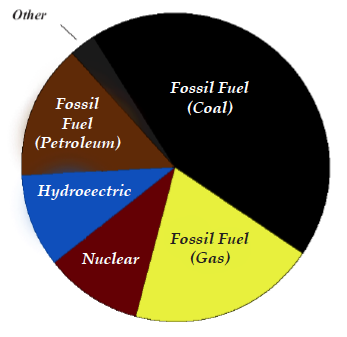EU4. Field Trip To a Power Plant
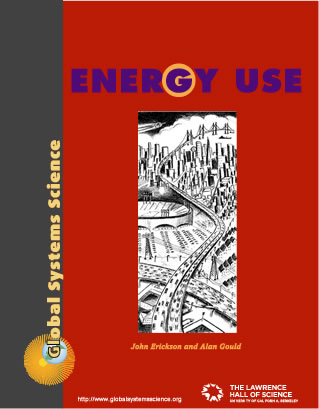
Chapter 4
Electricity, from the power plant to your toaster
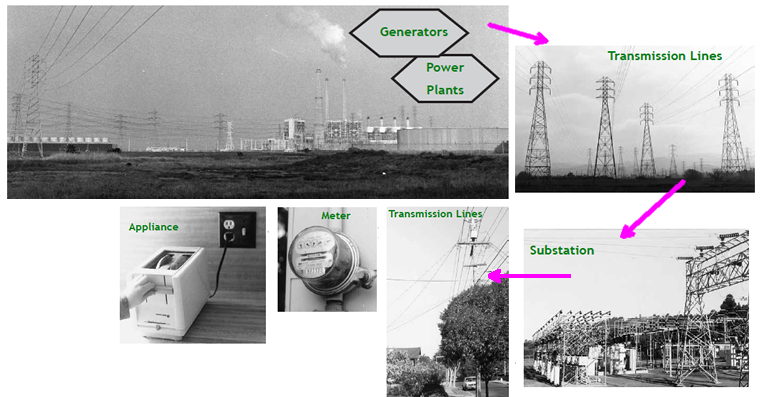
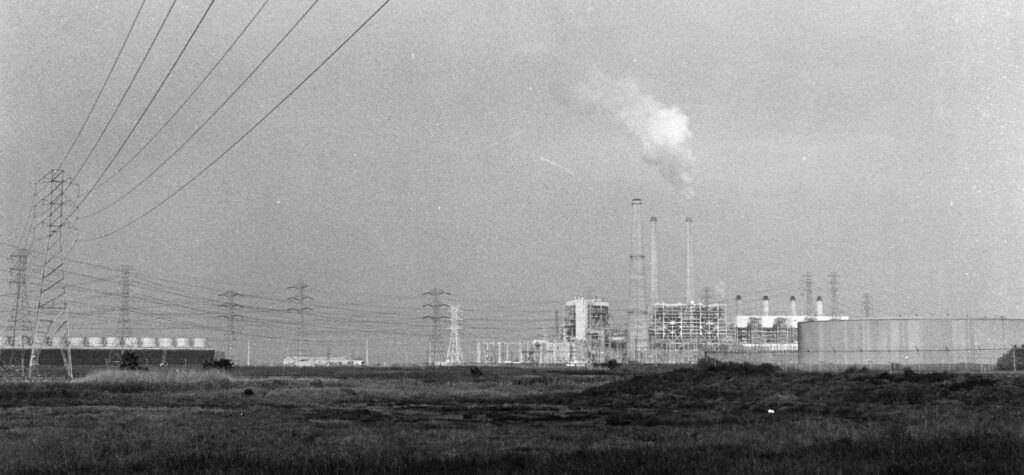
Marty Hunt told us the power plant would be on the right, when we turn onto Tenth Street, and we couldn’t miss it. There is no question we are headed in the right direction. Steel towers loom over the countryside holding up power lines that are spread out in all directions across pastures and green hills.
After getting our visitor’s passes at the gate, we drive past acres of fuel oil storage tanks. At the power plant itself, seven smoke stacks, each well over 300 feet tall, rise from an immense box-shaped tangle of pipes, duct work, and cables. From one of the stacks a cloud of white smoke tumbles upward, a mixture of water vapor and carbon dioxide.
Mr. Hunt, a project manager at a power plant run by Pacific Gas and Electric in Pittsburg, California, meets us outside his office. “This plant, like many electric power plants, has more than one generating unit, each with separate boilers, steam turbines and electric generators,” he tells us. “The Pittsburg Plant is like seven power plants in one. Each can burn either oil or natural gas, but natural gas is almost always used because it burns much more cleanly.” Today only one unit is operating.
“It is a good day to look around. A major overhaul of two of the units is in progress. Some machinery is dismantled, giving a good opportunity for us to see the inner workings,” he said. We put on hard-hats and begin the tour.
We thread our way up several flights of outdoor staircases to the platform where the generators are being rebuilt. The generator in a typical fossil fuel power plant is spun by a steam turbine.
Fossil fuel is burned to boil water in a boiler, creating steam at a high temperature and pressure. The steam from the boiler hits the fan-like blades of the turbine and causes it to turn. This is where the heat from the burning fuel that went into the boiler gets converted to spin the generator.
The turbine works best when the pressure of the steam going in is as great as possible and the pressure of the steam going out is as small as possible, Mr. Hunt said. “In the newest and most efficient turbine at the Pittsburg Plant, the steam enters at a pressure of 3,500 psi [pounds per square inch] and at a temperature of 1,000 °F [more than 500 °C].”
Pressure Unit
Psi stands for “pounds per square inch.” Right now on every square inch of your body the atmosphere is pushing with a force of about 15 p.s.i.
After the steam leaves the turbine it goes to the condenser to be cooled. As steam condenses to liquid water it contracts, reducing the pressure on the output side of the turbine to a small fraction of the pressure on the intake side.
Question 4.1
How many times greater is the steam pressure in the power plant?
“Part of my job,” said Mr. Hunt, “is overseeing the rebuilding of the condensing system. Cooling the steam for just one generating unit requires 2000 gallons of water every minute. Enormous pumps pull the water in from the freshwater bay next to the power plant. Elaborate moving screens filter out the larger bits of trash and natural debris. This water is then sent to the condenser to soak up the heat from the ‘used’ steam.”
The inside of a steam turbine? This looks like a steam turbine, but it actually is a pump. Think of a pump and a turbine as the reverse of each other. In a turbine, a fluid flows past the blades forcing them to turn. In a pump, spinning blades force the fluid to flow.
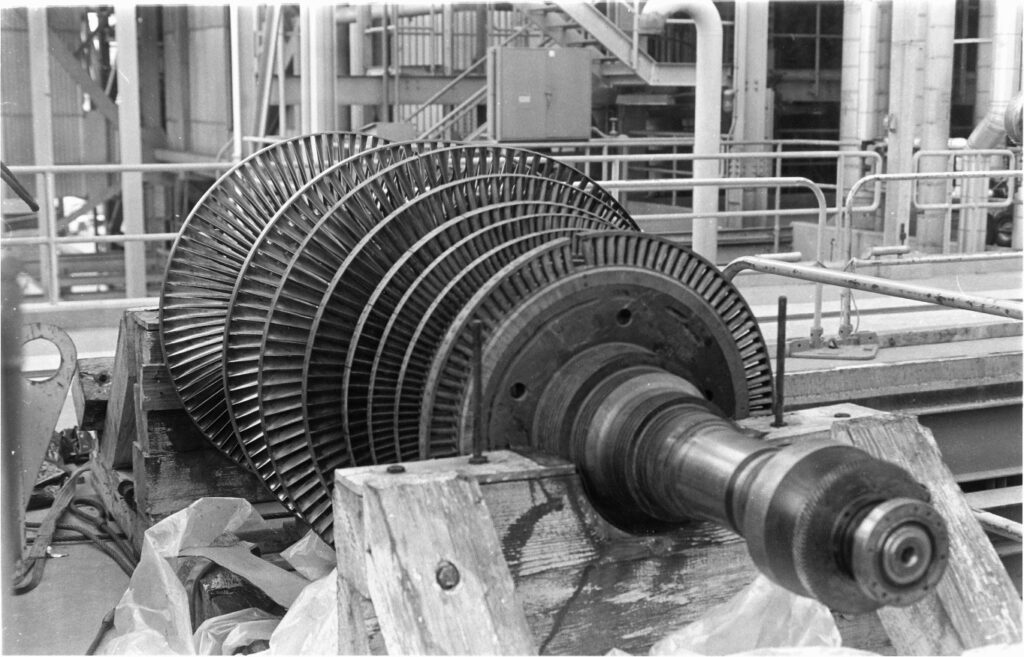
The real turbine is encased in the housing shown in this photo.
If this heated water were returned directly to the bay, its temperature would disrupt the ecosystem. To avoid this thermal pollution, as it is called, the water goes through cooling towers which transfer heat to the air.
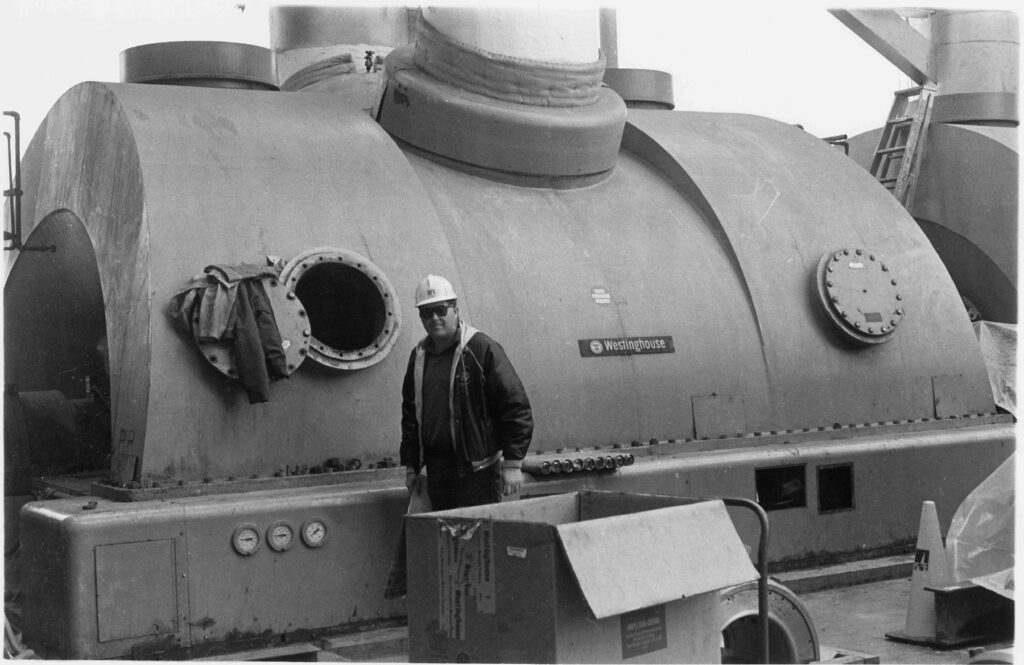
The Pump feeds the water back into the boiler to begin the cycle again.
Cooling towers are a prominent feature of many steam powered electrical generating plants. After passing through the cooling towers at the Pittsburg Plant, water goes through two miles of open channels before it reaches the bay. Even so, the water is warmer than the natural temperature of the bay.
The warmth of the water, and the fact that the water contains the remains of small fish that have been sucked through the system, makes this part of the bay attractive to large fish. It is a favorite spot for fishermen.
Mr. Hunt leads us through the unit that is operating today. Down at the level of the boilers we feel the heat as we peek at the flames through tiny windows. The heat is well contained. The noise, mainly from fans, is loud. On the wall hangs a bin of ear plugs for workers who have to spend time here.
Water Circulates in a Closed Loop in a Steam Generating Plant
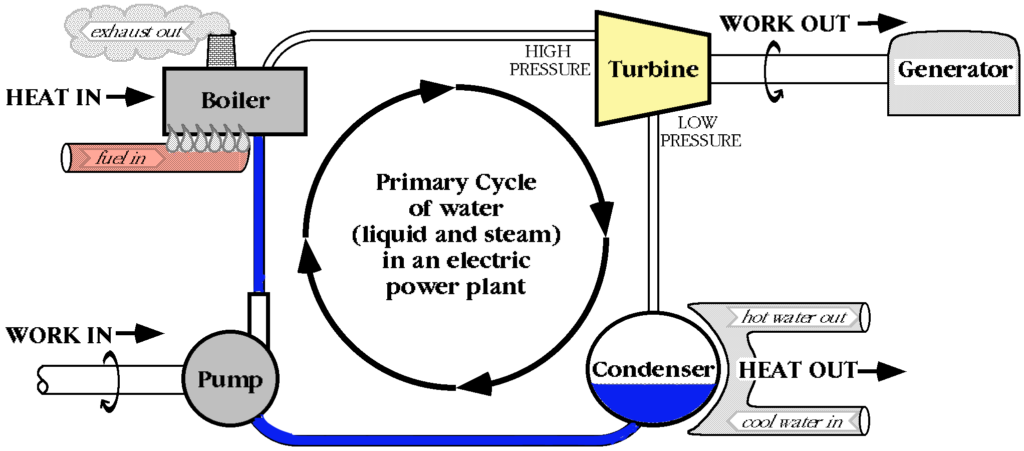
Question 4.2
Which is greater, the work the turbine does or the work needed to run the pump? Why?
Up above, where the generator is running, there is not much to see. It is completely hidden in its housing, but you can feel the vibration of the rapidly spinning mechanism. The turbines, the generator, and a pump that pushes condensed water back to the boiler are aligned on a single shaft, which must turn at exactly 3600 rpm (revolutions per minute) to maintain the AC electricity frequency of 60 cycles/second. The electricity from the generators goes through high voltage transformers, in and out of acres of switching mechanisms, and then off across the countryside through power lines.
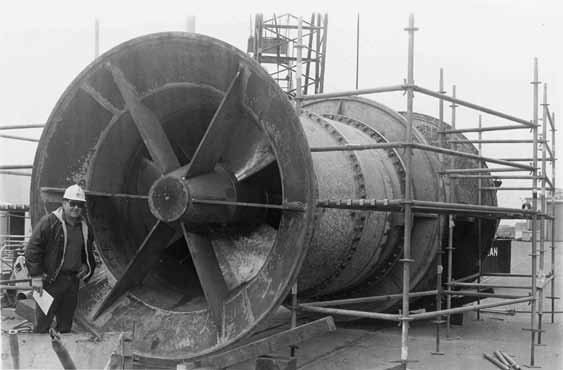
Some of the electricity that is produced is used right at the power plant. All the pumps, fans, generator exciter coils, and other miscellaneous electrical equipment needed to run each generating unit use several megawatts [a megawatt is a million watts]. “We are our own best customer,” Mr. Hunt said.
We step into the control room. Three power plant operators are at their desks in front of panels full of switches and monitoring devices that stretch to the ceiling. Emergency warning lights are lit up on top of the control panels. Fortunately, these lights have no significance today because this control room is for one of the units that is shut down. Switches are tagged with labels declaring in bold print, “Man On Line,” so that those systems are not be activated from the control room while a worker, man or woman, is working on it outside.

When we ask what is involved in operating a power plant they joke, “You can see we do not need to dress up for the job. Not like in the nuclear plants where they all wear neck ties.” Ron Franklin, a senior control operator who has been at the plant for 21 years, said, “In all seriousness, this job is a challenge. It takes a team to do it.
“Even though much of the process is automatic, and some of the work is routine, we are dealing with materials at extreme pressures and temperatures, and equipment moving at rapid speeds generating many megawatts of electric power. We are responsible for the safety of the equipment and the people who work on it twenty four hours a day.
“When a steam pipe has a leak or a pump has stopped working the operators must keep the equipment from destroying itself and, if possible, keep the generator running at the same time.
“In addition to the control room for each generator there is a system control room for all the power plants in each region of the power grid. We get messages from the system control room in San Francisco about how the grid is operating and how much power is needed from our generator.
“I remember the time in 1989 when we lost contact with San Francisco. We didn’t need any message to tell us that there was an earthquake. Besides the usual bumping and bouncing we had the added effect of shifting I-beams and swaying smoke stacks. There was no major damage at the plant, but power lines were down everywhere and electric current stopped flowing. When the current stopped flowing the load on the generator went down and the driving energy of the steam turbine made it spin faster. As the shaking settled after the quake the generator frequency rose up above the usual 60 cycles per second. Even though we were out of contact with the system operators in San Francisco, we figured out what was happening and decided what to do.”
As we drive home, power lines stretch along the highway beside us. Perhaps they were the ones that carry electricity to the substation in our neighborhood. We left behind a system engineered to provide more than 2,000 megawatts of electricity. When it was built about 50 years ago it produced only a third as much. As people demanded more, additions and improvements were made.
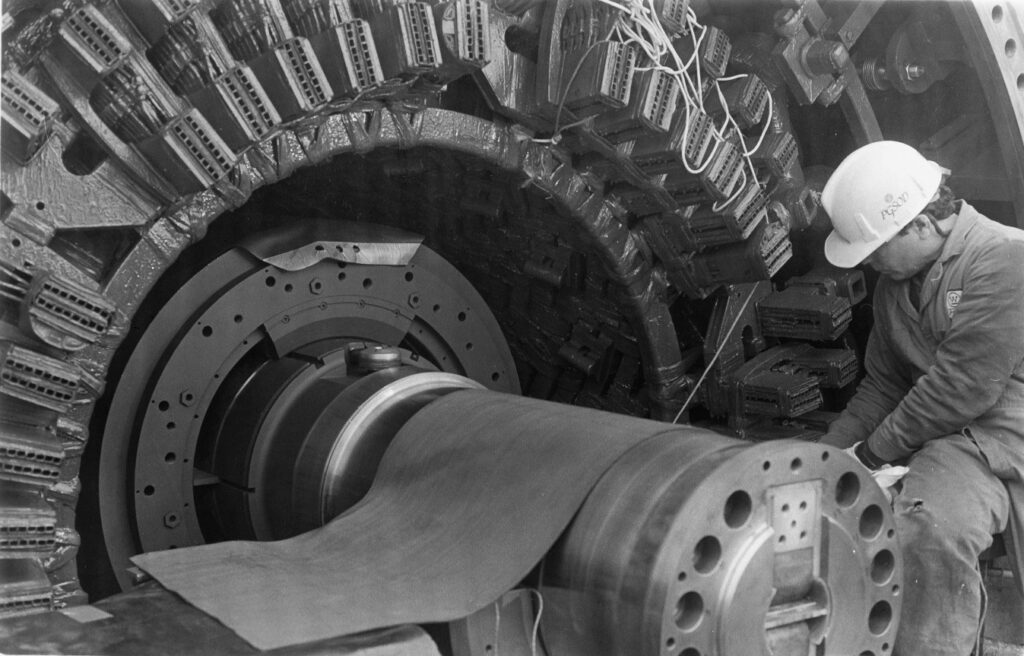
We expect additions to continue, especially outside the United States. Demand for power abroad is expected to grow 10 times faster than here. In China alone the use of electricity is expected to grow by 15,000 megawatts per year. That is like opening seven additional Pittsburg power plants every year.
The Pittsburg Plant, like many others, is a fossil fuel burning plant. We wonder how many future power plants the Earth can provide fuel to run? We stop for gas—our tank is low.
Find These Items in the Photograph:
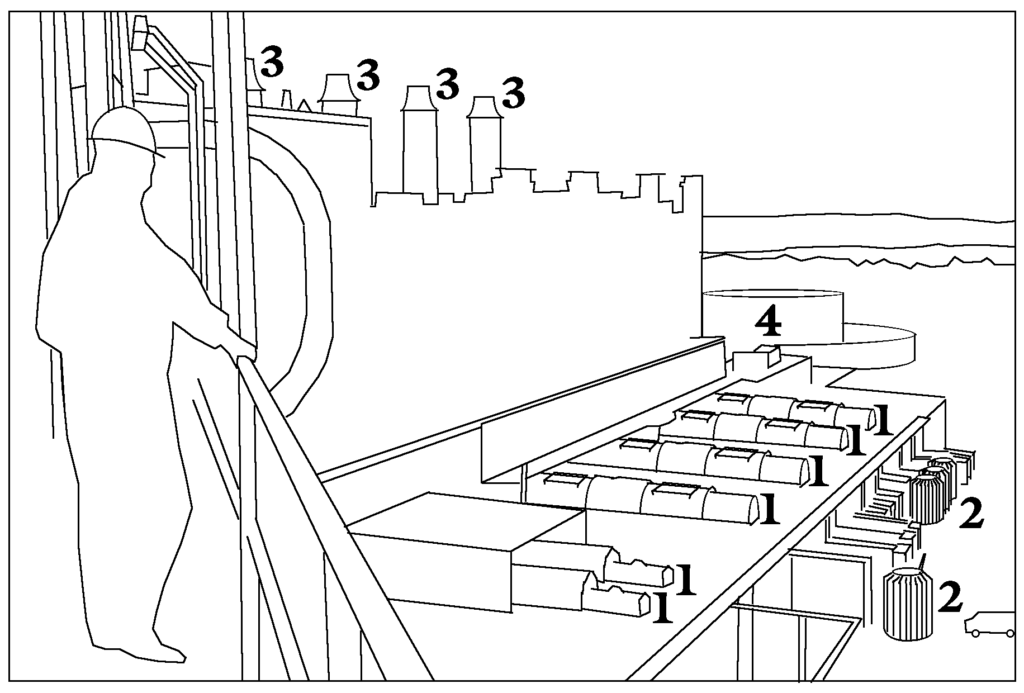
- Generating Units (which include the turbine, generator, and the boiler feed pump)
- Transformers
- Smoke Stacks
- Oil Storage Tank
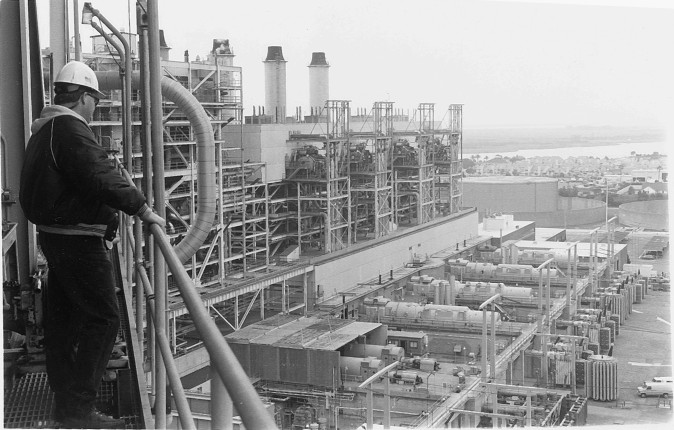
I. A Survey of Power Plants
Electric power flows into the grid from a variety of different kinds of power plants. Each kind has its advantages and disadvantages. As you learn about each kind consider the following questions.
- What is the source of the energy that feeds the power plant?
- What energy transformations occur between the power source and the output of electrical energy?
- Is the energy source renewable?
(An energy source is said to be renewable if it can be replenished at least as fast as it is used.)
Question 4.3
What is the ultimate source of the energy that feeds a fossil fuel power plant?
[ Hint: It’s not the fossil fuel!]
Question 4.4
What energy transformations occur between that ultimate power source and the output of electrical energy?Fossil Fuel Power Plants
In the United States, 2,110 power plants burn fossil fuels (coal, oil, and natural gas) generating about 73% of the nation’s electrical energy. Most of the plants use steam to drive the turbines, like the one in Pittsburg, California. Some of the plants use the hot gases from combustion of fuel to turn the turbine directly, and a smaller number use large internal combustion engines, like those that run cars and trucks, to turn the generators.
The main advantage of fossil fuel power plants is that daily operating costs are relatively low. So many have been built that engineers have learned to construct them so they are very efficient. Some of the disadvantages are:
- They emit pollutants such as nitrous oxide and sulfur dioxide.
- Mining coal and drilling for oil and gas are expensive, dangerous, and often injurious to the environment.
- Transportation of oil has resulted in hundreds of accidental oil spills.
- Fossil-fuel power plants are the main source of acid rain.
- Fossil fuels are a nonrenewable energy source. Current reserves will be gone long before new ones are formed .
- Fossil fuel power plants are major contributors of “greenhouse gases” to our atmosphere—40% of the carbon dioxide added to the atmosphere comes from fossil fuel power plants.
All these disadvantages are “hidden costs” that make it difficult to assess the real costs of electricity.
Nuclear Power Plants
In December 1993, the total number of nuclear power plants in the United States was 109, collectively producing 610 billion kW-hrs of electricity. As of 2004, nuclear power plants were producing about 20% of electric power in the United States. They are fueled by enriched uranium.
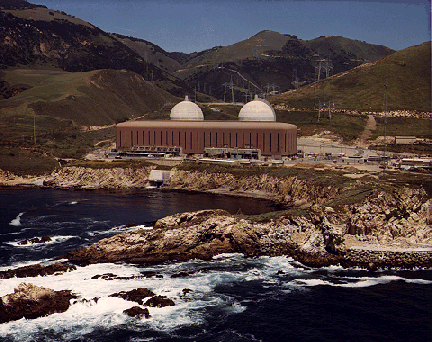
In nuclear fission, the nucleus of a uranium atom becomes unstable and splits into two smaller nuclei. That splitting produces heat. The heat boils water to drive steam turbines.
In normal operation, nuclear power plants do not emit air pollutants or greenhouse gases. Very small quantities of fuel can produce large amounts of energy. Energy analysts weigh these advantages against the following disadvantages.
- Uranium is a nonrenewable fuel.
- Thousands of tons of highly radioactive waste is left over and stored in containers. The radioactive waste will remain dangerously radioactive for many thousands of years and must be stored in safe waste storage facilities for those long time periods. However, no “permanent storage solution” has been accepted.
- Accidents can have widespread repercussions. In the former Soviet Union, the Chernobyl nuclear power plant exploded, spreading radioactive material into the air eventually killing and injuring many people. In the United States, a serious accident was narrowly averted at the Three Mile Island nuclear plant in Pennsylvania.
- Waste ores from uranium mines present a health hazard.
- Nuclear power plants are costly, and insurance companies will not insure them because the consequences of accidents are so severe.
- A nuclear plant operates for 30 to 50 years, and then it must be shut down (decommissioned). Decommissioning a nuclear power plant is very costly, since many components are highly radioactive.
No new nuclear power plants are planned for the United States, however Japan and some countries in Western Europe depend heavily on nuclear power.
Question 4.5
What is the ultimate source of the energy in nuclear power plants?
Question 4.6
What energy transformations occur in nuclear power plant?
For more about nuclear power, see World Nuclear Association – http://world-nuclear.org
Related to nuclear power is the issue of nuclear war. As with many technologies, nuclear energy can be used constructively or destructively. The following article (excerpts) appears in the staying current page for the GSS book Climate Change chapter 10, since nuclear war would cause severe climate change. But in some ways it is equally relevant to the book Ecosystem Change as well as this section on nuclear power:
2021 December 2. Geoscientists Can Help Reduce the Threat of Nuclear Weapons. By Alan Robock and Stewart C. Prager, Eos/AGU. Excerpt: While we all recognize that global warming threatens humanity, the effects of nuclear war pose an even graver threat to the global population. …Currently, there are more than 9,000 nuclear warheads in the active military stockpiles of nine nations, with more than 90% of those in Russia and the United States. Nearly 2,000 warheads are on alert status, ready to launch within minutes of an order. …The nuclear arms control regime has been weakened in recent years with the termination of the Anti-Ballistic Missile Treaty and the Intermediate-Range Nuclear Forces Treaty between Russia and the United States, … and the withdrawal of the United States from the Iran nuclear deal. …a nuclear conflict would cause rapid changes in Earth’s climate. Smoke from firestorms ignited by attacks on cities and industrial areas would rise into the stratosphere and persist for years [e.g., Yu et al., 2019]. …it would lead to stratospheric ozone depletion that would enhance the amount of ultraviolet radiation reaching Earth’s surface [Bardeen et al., 2021]. …The original suggestions of “nuclear winter” following a nuclear war by Turco et al.[1983] and Aleksandrov and Stenchikov [1983], …have been supported strongly by recent work using modern high-resolution general circulation models to simulate and predict its effects [Robock et al., 2007a; Coupe et al., 2019]. …the multiyear lifetime of smoke in the stratosphere means the effects on climate would last a decade, with the largest impacts continuing for more than 5 years. Such a conflict would decrease crop production to an extent that it could seriously threaten world food security and even trigger global famine [Jägermeyr et al., 2020; L. Xia et al., Global famine after nuclear war, submitted to Nature Food, 2021]. …to reduce the likelihood of using nuclear weapons, …we can adopt a no-first-use policy, …eliminate the launch-on-warning option, …and we can eliminate presidential sole authority to launch nuclear weapons. …We believe that the ultimate solution to the problem of nuclear weapons is to ban them globally. In 2017, the International Campaign to Abolish Nuclear Weapons led the effort to have the Treaty on the Prohibition of Nuclear Weapons signed at the United Nations.… [https://eos.org/opinions/geoscientists-can-help-reduce-the-threat-of-nuclear-weapons]
Geothermal Power Plants
Anyone who has seen pictures of lava flowing out of volcanoes is aware that the interior of our planet is hot enough to melt rocks. This heat comes from naturally occurring minerals, such as uranium, which consist of atoms that break down, or decay. When these atoms decay they are changed into lighter elements and they release heat.
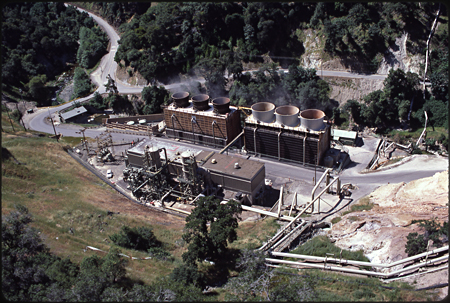
There are no smokestacks at this plant. Notice the mist rising from the cooling towers.
Photo courtesy PG&E.
In some places the molten rock comes fairly close to the surface, but not so close that it erupts as a volcano. However, it may heat groundwater creating hot fountains of water called geysers. These are good sites for geothermal power plants.
Power plants that use the naturally occurring heat within the Earth to drive steam turbines are called geothermal power plants. Geothermal energy is a very clean energy source when compared with either fossil fuel or nuclear power. There are a number of sites especially suitable for this, including areas of Northern California, Wyoming, Hawaii, New Zealand, Japan, and Iceland.
Hawaii is an excellent candidate for geothermal power production. On the Big Island, where there are active volcanoes, a geothermal project is underway. However, local opposition to this project believes the geothermal plant is an unacceptable intrusion into the local ecology as well as an insult to Pele, the goddess of volcanoes. Nearby inhabitants say toxic fumes are vented and make them sick.
A major advantage of geothermal energy is the magnitude of the energy source. The Earth has a tremendous amount of heat in it and our use of that energy is limited only by the technology we can devise to tap it.
Though the source is large, it is also unreliable. As steam is drawn from the ground, and as the surface of the Earth goes through natural changes, the energy available at a particular geothermal site can drop. The largest geothermal plant in the world is at Geysers in Northern California. It originally had a generating capacity of 500 megawatts, but currently operates at only 60% of that level.
Question 4.7
What is the ultimate source of the energy in geothermal power plants?
Question 4.8
What energy transformations occur in geothermal plants?
Solar-Thermal Electric Power Plants
In a solar-thermal power plant, sunlight is reflected by a field of many large mirrors, and concentrated onto a tank of molten salt. The heat of the molten salt is used to boil water and produce steam, which turns a turbine for production of electricity.
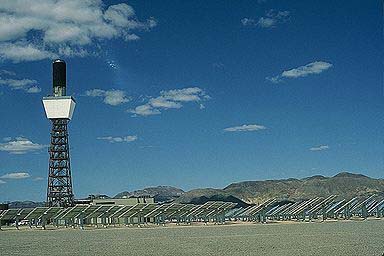
The mirrors are controlled by computers so they track the Sun along its path across the sky. Solar-thermal power plants have the advantage of being clean energy sources with no fuel costs. The source is considered renewable because sunshine is not depleted.
The main disadvantage of solar-thermal electric power is that the energy must be stored or backup systems employed for times when the sun is not shining—at night and on cloudy days. Possible storage systems include storage batteries, pumping water from a low reservoir to a high reservoir for later use with a hydroelectric generator, and production of hydrogen for later use in a fuel burning power plant.
Question 4.9
What is the ultimate source of the energy for solar-thermal electric power plants?
Question 4.10
What energy transformations occur in solar-thermal electric power plants?
Thermal Electric Power Plants
All the power plants described so far depend on the direct use of heat. In each of the power plants we’ve seen, heat, converted to work in a turbine, drives the generator. Such power plants are called thermoelectric power plants. Fully understanding these power plants requires some knowledge of thermodynamics—the study of heat and work.
You will find out more about thermodynamics in chapter 8. For now, there are just two things you need to know.
- Converting heat to work in most thermoelectric power plants is only about 30% efficient. That means that 70% of the heat is not converted to electricity. The wasted heat is carried away by hot water from the condenser.
- The inefficiency of a thermoelectric power plant is not because of poor design. According to the laws of thermodynamics, the process of doing work with heat must be inefficient. It takes a good design to reach the 30% range.
Not every power plant is limited to 30% efficiency by the laws of thermodynamics. On the following pages are descriptions of some power plants that are not thermoelectric.
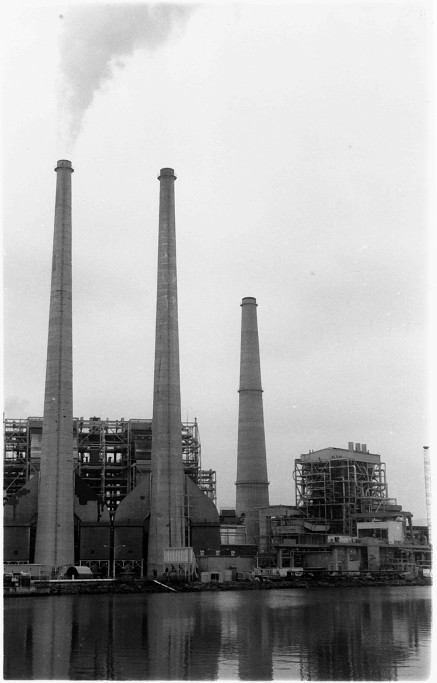
Hydroelectric Power Plants
A hydroelectric plant uses the force of gravity acting on water to drive its generators.
There are currently 1,253 hydroelectric power plants in this country, located along major rivers. Together, they produce about 12% of our nation’s electrical energy. The most efficient systems are large dams that create deep reservoirs of water. High water pressure is ideal for driving water turbines.
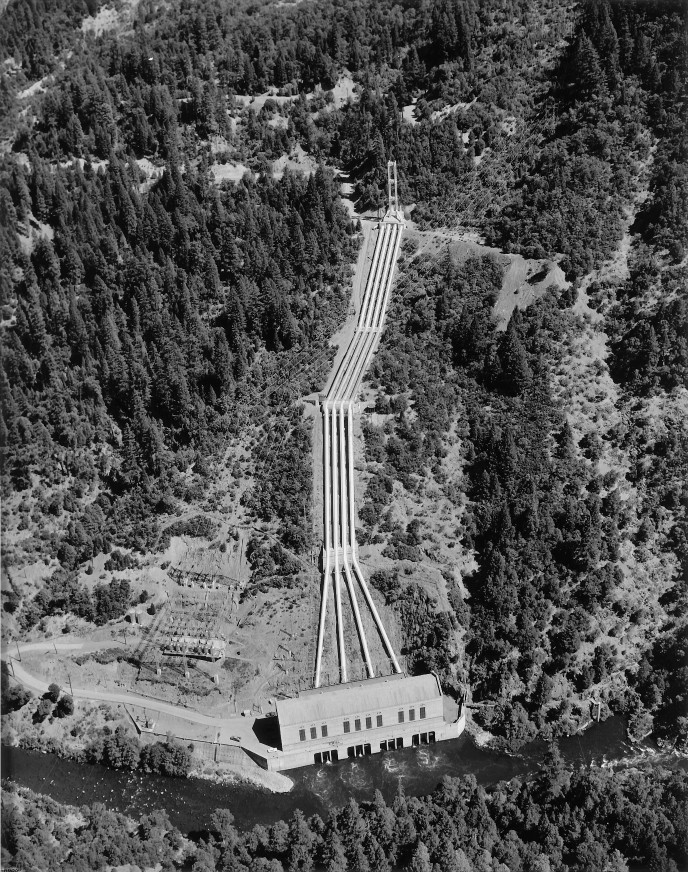
The building houses the water turbines and generators. Water comes through the pipes from a reservoir high up the mountain side. It is the difference in altitude between the reservoir and the turbines that give the water its potential energy. Photo courtesy of PG&E.
Hydroelectricity is a clean energy source in terms of pollution. It is relatively inexpensive, and requires no fuel because its ultimate source is the Sun, which drives the water cycle that fills reservoirs.
Disadvantages include:
- Large tracts of land must be submerged under reservoirs, destroying sections of land ecosystems, disrupting the life cycle of fish and aquatic ecosystems.
- Reservoirs fill up with silt carried by river currents. The lifetime of a typical hydroelectric plant is 50 years until the reservoir is too full of silt to be useful.
Hydroelectric power plants have already been built at nearly all of the suitable sites. The few potential sites that remain are controversial because they involve the flooding of wilderness areas. Consequently, it is not likely that any new hydroelectric power planets will be built in the United States.
Question 4.11
What is the ultimate source of the energy in hydroelectric power plants?
Question 4.12
What energy transformations occur in a hydroelectric power plant?
Wind Generators
Hundreds of years ago, wind power was used to turn grain grinding mills. When you drive by old farms and ranches, you often see old-style windmills that were used to pump precious water for irrigation.
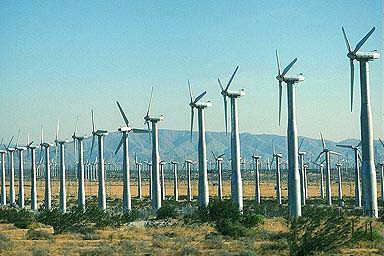
Most modern windmills are being used to generate electricity. For wind machines to generate significant amounts of electricity, the wind must be at least 20 miles per hour. It is wise to conduct detailed wind surveys of a site to determine annual wind variations, before deciding to install wind electric generators.
Disadvantages of wind power include:
- Birds can be killed by spinning wind turbines.
- People living nearby may object to the noise and appearance of wind turbines.
- Even at windy sites, wind is an intermittent event, so wind electric generators alone cannot provide all our electrical needs. Either the generators must be linked into a public utility to supplement other electric power sources, or the wind generators must have their own system of storing electricity for use when there is no wind. Storage systems such as those used with solar-thermal electric power can be used to store electricity from wind generators.
The main advantages to wind electric power generation are that it does not pollute the air or water, and has no fuel costs.
Question 4.13
What is the ultimate source of the energy in wind generator systems?
Question 4.14
What energy transformations occur in wind generator systems?

EU4.1. Investigation:
Home Heating Dilemma
“Mom, Dad, the newspaper has this great article about natural gas. It’s clean and it’s cheap, and it might be getting cheaper. I think we should get rid of our electric heating system and switch to natural gas.”
“Hold on!” said Mom. “Didn’t you know that the electric power in this area comes almost entirely from natural gas? There is no need to switch.”
“That’s right,” added Dad. “What’s the difference whether the gas is burned in our furnace or in some electric power plant?”
1. Burn it in a furnace in your house. You will either have it delivered through a pipeline or have containers delivered as needed to your home.
2. Have the utility company burn the gas and convert about 30% of the energy to electricity that will come to your home conveniently through the electric power lines to an electric heater.
3. Move into a neighborhood where a gas-burning power plant is to be built, and where there is a plan to pipe hot water from the condenser into nearby homes where it can be used for home heating.
Question 4.15.
What is the difference if gas is burned in your furnace or in some electric power plant?
What are the pros and cons of each of the three ways to heat a home with natural gas?

EU4.2. Investigation: The Future of
Electric Power Production
Question 4.14
What percent of electrical power in this country is from burning fossil fuels?
How do you think the percentages of different plants will change in 50 or 100 years?
Why?
Question 4.15
Imagine a developing nation, such as China, hired you to advise them on what types of power plants they should build to provide their citizens with lights, TVs, and other modern conveniences. What kind(s) of power plants would you recommend?
Why?
| Number of Power Plants | Megawatts of Power | Percentage of Power | |
|---|---|---|---|
| Fossil Fuel (coal) | 1,198 | 325,001 | 43.3% |
| Fossil Fuel (Gas) | 2,148 | 147,260 | 19.6% |
| Fossil Fuel (Petroleum) | 3,321 | 76,511 | 10% |
| Hydroelectric | 3,352 | 73,202 | 9.7% |
| Hydro Pumped Storage | 141 | 18,669 | 2.4% |
| Nuclear | 107 | 107,632 | 14.3% |
| Geothermal | 27 | 1,746 | 0.2% |
| Solar | 11 | 5 | less than 1% |
| Wind | 19 | 14 | less than 1% |
| Wood | 8 | 261 | less than 1% |
| Total | 10,332 | 750,301 | 100% |
II. Conclusion
The size of the U.S. electrical power industry is vast: 6,667 operating fossil-fuel plants; 3,352 hydroelectric plants; 107 nuclear power plants—plus all the substations and connecting power lines. The costs for running and maintaining this industry is about $200 billion per year. The impact of this industry on the environment is immense. But power plants are only part of the picture. How we get the electrical energy from the power plant to your home is the subject of the next chapter.
